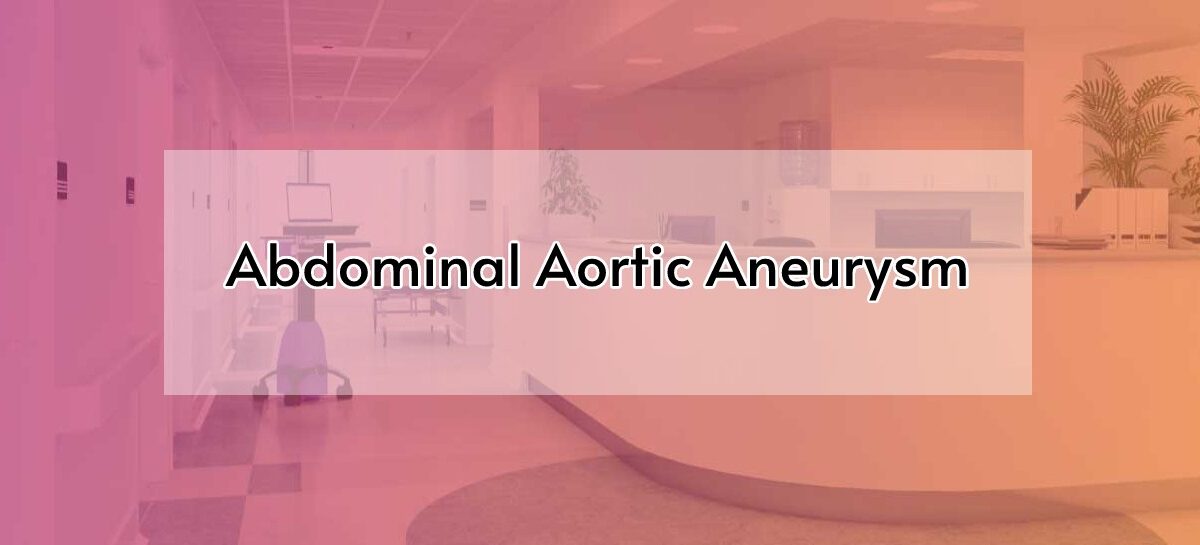Aortic aneurysms can form anywhere along the aorta, but approximately 30% of aneurysms are found in the infrarenal aorta. Risk factors for AAA include advanced age, male gender, smoking, COPD, atherosclerosis, family history of AAA, hypertension, hypercholesterolemia, and Marfans syndrome and other connective tissue disorders. Age has been determined to be the most significant risk factor for the development of AAA.
Diagnosis of aneurysm is crucial because rupture is a catastrophic complication that can occur when the aneurysm enlarges. Majority of the aneurysms are asymptomatic and are usually picked up during routine ultra sound examination done for other reasons. Patients sometimes are aware of pulse in their abdomen when the aneurysm is large. Rarely the aneurysm may compress the adjacent viscera and produce vague symptoms like dyspepsia, vomiting and ureteric obstruction. Vertebral erosion can cause back pain. Thrombosis and distal embolization can also occur. Generally any symptom associated with AAA must be considered as threatened rupture and must be intervened immediately. Rupture of AAA must be ruled out whenever any hypertensive male presents with severe abdominal or back pain.
Risk of rupture and size:
The rate of enlargement for small abdominal aortic aneurysms is 0.3 to 0.5cm/year. Studies have shown that the rupture risk is less than 1% when the aneurysm is less than 4cm and increases significantly to 6.5-15% when aneurysm diameter is between 5-6 cms.
Management
Mortality after elective aneurysm repair is between 1-5% whereas mortality after rupture ranges from 50-70%. Hence primary prevention of modifiable risk factors, as well as timely identification and intervention before rupture can occur, are the primary components to mitigate mortality from this disease entity.
Most of the time the initial diagnosis is done by routine ultra sound examination of the abdomen.
Correct measurement of the size, true extent, and other anatomical details are best assessed by a contrast CT aortogram. Correct measurements are to be done if endovascular management is planned. Non-contrast MR aortogram can be done for patients with renal failure but the imaging is not as good as a CT aortogram.
Medical management of Small aortic aneurysm.
Aneurysm smaller than 4 cms can be medically managed and followed up regularly. Sine the rupture risk is less than the operative mortality risk these patients can be carefully observed. All modifiable risk factors such as smoking, dyslipedemia, diabetes and hypertension should be corrected. Beta blocker has been shown to reduce the stress on the sac wall and reduce the expansion rate of the aneurysm. Similarly statins also have been shown to reduce the expansion rate. Another drug that has similar effect is Doxycycline which blocks Matrix metallo protease which is responsible for the damage to the elastic fibre and aneurysm development. All patients with small abdominal aortic aneurysms need periodic follow up with a duplex scan every 6 to 12 months to ensure that the aneurysm is not expanding.
When to intervene;
All abdominal aortic aneurysms that has reached the diameter of 5.0 cms should be advised intervention even if they are asymptomatic. Similarly all symptomatic aneurysms irrespective of size should be operated.
Open repair of AAA
Open repair of AAA is the gold standard of treatment and should be advised for all patients who are surgically fit to undergo this major operation. An open repair involves a long midline incision followed by replacement of the diseased aorta with a graft (Fig. 1&2). Postoperatively, these patients need close monitoring and ICU care Mortality of elective aneurysm repair is 1-5% depending on the associated risk factors. Age >70,COPD, congestive heart failure and renal failure are the risk factors associated with higher mortality. Late complications are rare and the patient does not need rigorous follow up unlike after endovascular repair.
Endovascular Aneurysm Repair (EVAR)
In EVAR bifurcated stent graft is placed across the abdominal aorta and iliac arteries through femoral artery (Fig 3&4). Thus it avoids laparotomy and aortic clamping and complications. Hence the perioperative complication and mortality are less than open operations. But there is no improvement in long term survival. The dis advantages are
- Anatomical suitability of the aorta. Both proximal and distal landing zone should be free of disease.
- Lifelong follow up is needed since migration and endoleaks can occur at any time.
- Higher incidence of reintervention
- Much costlier than open repair.
With improvement in newer devices, the safety and durability of the stent grafts have improved and the reintervention rate have come down.
Conclusion
Young patients who are fit should be taken up for open repair.
Patients who are not anatomically suitable for EVAR also should be taken up for open repair.
Patients who are higher risk for open surgery and anatomically suitable can be taken up for EVAR

Fig 1. Pre operative CT aortogram showing Infra renal abdominal aortic aneurysm

Fig2. Aortic aneurysm has been replaced by a bifurcated dacron graft. Arrow points to the graft to the lower polar renal artery

Fig3) Large infra renal aortic aneurysm anatomically ideal candidate for EVAR

Fig4) Same patient post op CT one month after EVAR. Graft ideally placed. There is no endoleak and good distal flow maintained.



 Dr. Jan Sujith, MBBS, MS General Surgery, MCh Vascular Surgery
Dr. Jan Sujith, MBBS, MS General Surgery, MCh Vascular Surgery